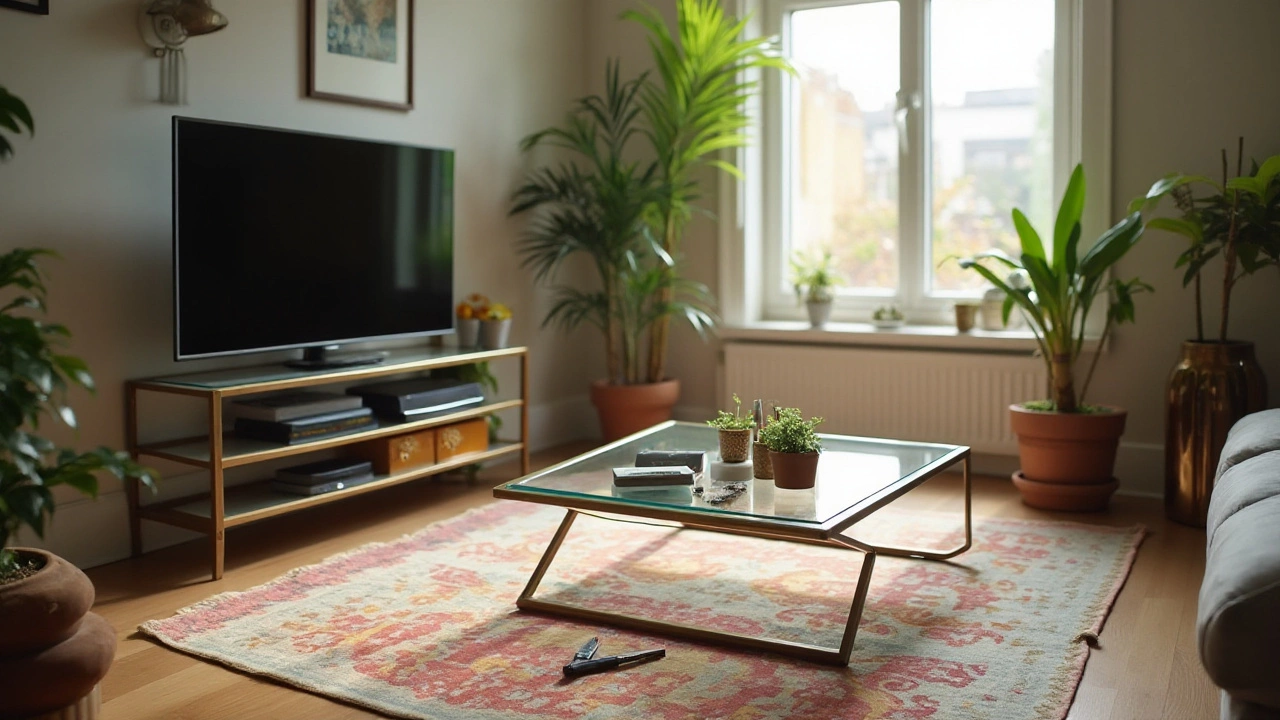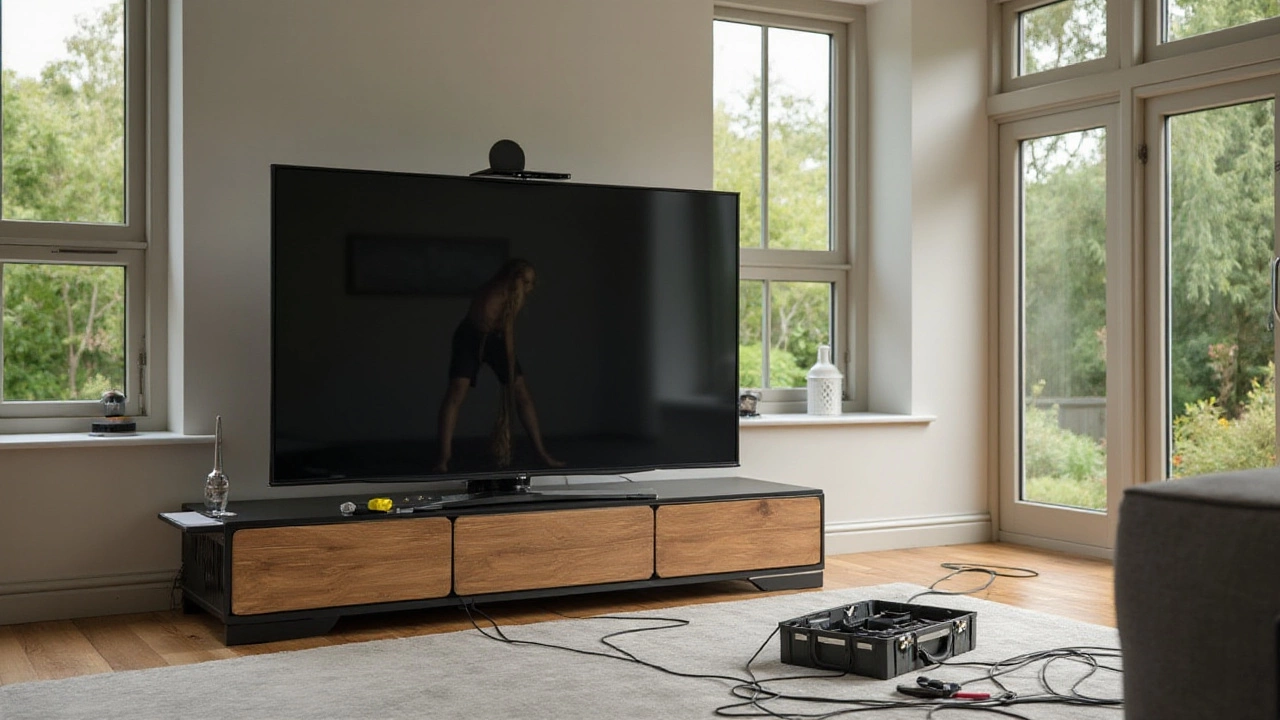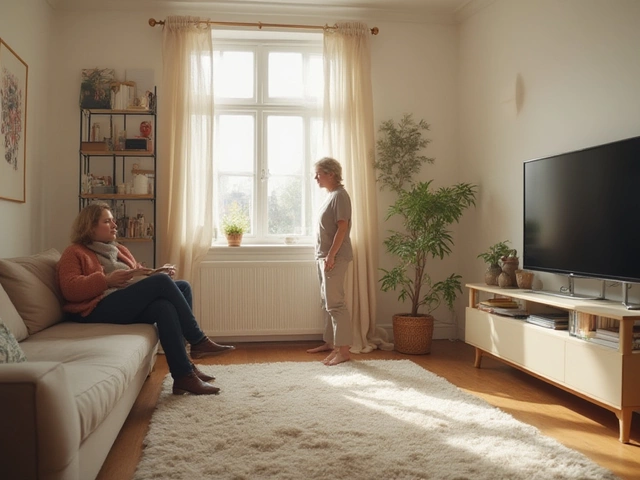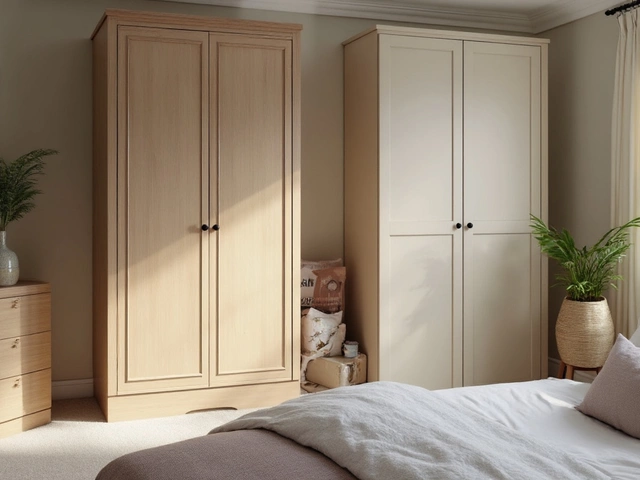Rearranging your living space often calls for a fresh approach to how you position your television. If you find yourself eager to convert a wall-mounted TV into a stand-supported fixture, you're not alone. Many seek this change to keep up with shifting design trends or simply to avoid drilling more holes in the walls of a rented property.
Let's break down the process, making sure you have a clear roadmap for the task at hand. This exploration will guide you right from choosing the perfect stand to ensuring all the cables are neatly managed, offering insights into making the transition safe and enhancing your room's aesthetics.
- Understanding the Need
- Choosing the Right Stand
- Gathering Tools and Materials
- Uninstalling the Wall Mount
- Installing the TV on the Stand
- Cable Management and Safety Tips
Understanding the Need
When it comes to reimagining your living space or creating a more versatile viewing environment, converting a wall-mounted TV to a stand-supported setup can be an essential step. The decision is often driven by a variety of factors that point toward a desire for change. A wall-mounted configuration typically appeals to minimalists and those looking to save floor space. However, as time goes by, practicality and convenience often take precedence, leading many to reconsider their TV placement. For instance, you may want to rearrange furniture layout, or perhaps rent a new apartment where drilling walls isn't permitted. The flexibility to shift between different layouts without the hassle of re-installing wall mounts makes TV stands an ideal solution.
In addition to changing aesthetics and functional needs, homeowners frequently pursue this transition to accommodate technological upgrades and lifestyle changes. As screen sizes expand and home entertainment systems become more complex, the standard fixed wall placement can feel restrictive. For those who enjoy experimenting with interior design, a TV stand offers the liberty of repositioning the screen as per the occasion or specific viewing requirements. For example, movie nights demand a certain ambiance where seating arrangements might center around the television more closely, thus necessitating a stand.
Another major reason for this shift is the practical concern of maintaining and managing the wires and cables that come with modern TVs and gaming consoles. Often, these are clumsily tucked behind walls in a wall-mounted setup, making adjustments cumbersome. With a stand, you gain the opportunity for superior cable management, shifting them at will and keeping them neatly organized. A well-chosen TV stand can even provide additional storage spaces, meeting all your entertainment necessities in one place. Consider the adjustment period as a blank slate that allows for modernization with newer technologies without the constraint of fixed wall attachments.
The notion of transitioning to a TV stand reflects a larger trend towards creating multifunctional spaces that can adapt to a host of activities and preferences. A flexible approach to home design is key in today's dynamic living environments. As quoted by interior design expert Jane Greenwood,
"A room should feel collected, not decorated. The arrangement, including your TV placement, needs to reflect personal ease and adaptability."Such sentiments echo this growing need for functional freedom in our homes, advocating for convertible solutions that accommodate our evolving lifestyles.
Choosing the Right Stand
When it comes to transforming your cherished wall-mounted TV into a free-standing unit, selecting the perfect stand is crucial. The first step is determining the dimensions and weight capacity of the TV stand, ensuring it is compatible with your television. Most modern TVs come with detailed specifications, including the VESA mounting pattern, weight, and size, which are critical when selecting a stand. Consider the room's aesthetic and how the stand will blend with existing furniture. It doesn't just hold your TV, it becomes part of your living room's decor.
Another vital consideration is the material and durability of the stand. While wood provides a classic look and sturdy support, metal offers a sleek, modern feel and might suit different tastes and styles. Glass stands, though stylish, usually require more maintenance because of smudges and fingerprints, but might be desirable for an open, airy feel. Opt for stands with adjustable shelves or those that come with additional storage, like drawers or cabinets, if you need space for consoles, players, or other gadgets associated with your entertainment needs.
In terms of design, you have a variety of choices, ranging from traditional to ultra-modern. The style should align with the rest of your home's interior. If your room has a minimalist design, a stand with clean lines and a neutral palette might be just what you need. Something more avant-garde or rustic could complement homes with more intricate design elements.
According to interior designer Jane Lockhart, "A TV stand should not only enhance the aesthetics of the room but should be functional enough to accommodate all entertainment equipment."
Safety is also a key point to keep in mind, especially if you have young children or pets. A stand with a sturdy built and a solid base can prevent accidents and keep your TV secure. Look for features like anti-tip straps or a wall anchor kit for extra reassurance, turning your attention to models that offer these safety precautions. Some stands come with locking mechanisms that prevent them from tipping over, adding an extra level of security.
The next factor to consider is the height of the stand. Ideally, the center of your TV screen should be at or slightly below eye level when sitting down. This not only ensures ergonomic comfort but enhances the viewing experience by reducing strain on your neck. Adjustable-height stands are available for those who wish to customize their viewing experience further.
Finally, it might be worth looking into brands that offer modular designs, which allow you to adjust components over time. As televisions and technologies evolve, you want a stand that can adapt to new sizes or formats without needing a complete replacement. Investing in a high-quality, versatile stand can save you money and trouble in the long run, offering lasting satisfaction and keeping your setup future-proof.

Gathering Tools and Materials
To begin transforming your wall-mounted TV into a stand-supported setup, it's essential to gather all necessary tools and materials. This part of the process will ensure that you have a smooth and organized experience, minimizing the interruptions that can arise from missing components. To start, make a checklist of what you need. The basic tools generally include a screwdriver set, which is indispensable for both removing wall mounts and assembling the TV stand. Depending on the stand model, you might require either a Philips or flathead screwdriver, so having a complete set can be a lifesaver.
Besides screwdrivers, a socket wrench set may be required, especially for stands that come with larger bolts. It's often these small details that ensure a secure connection between the TV and its new base. Measure tapes should also be on your list—they help in ensuring that your TV is perfectly centered on the stand, which is crucial not only for aesthetic purposes but also to maintain balance and safety. If the shelf or the base of the stand requires assembly, an allen key set might be included with the stand, but it doesn’t hurt to have your own set just in case.
Essential Materials
Beyond tools, consider additional materials you might need. Most stands require securing your TV with screws, washers, and spacers, specifically designed for TVs. These are crucial for ensuring the TV mounts properly to its stand. Sometimes, the original wall mount screws can be repurposed, but always double-check compatibility. Another important aspect is cable management materials—these could range from cable ties and clips to sleeves that help keep the cables organized and untangled, maintaining that neat look.
"Preparation is the foundation of success." This quote by Alexander Graham Bell holds, especially true in DIY projects like this one, where the right preparation can preempt a host of potential issues later on.
If you’re someone who enjoys having visual guides, downloading the PDF manual of your TV and the new stand can be invaluable. These documents often provide detailed diagrams that can clarify any doubts about assembly or part compatibility. Not to ignore is the screwdriver with interchangeable heads, as it saves both space and time. Preparedness in this step significantly reduces the stress of mid-project tool hunting. Once you’ve equipped yourself with these tools and checked all the boxes, your journey from wall-mounted TV to a sleek, TV stand is already on a stable path.
Uninstalling the Wall Mount
When the decision to switch from a wall-mounted TV to a stand setup is made, it's crucial to know how to properly remove the existing mount. The first step in this transformation involves safely detaching your TV from its wall hardware. Begin by ensuring your television is turned off and unplugged from any power source. This basic safety measure prevents accidents and electric shocks.
Gather essential tools before proceeding; a screwdriver, preferably a Phillips head, is often crucial, but depending on your mount, an Allen wrench or socket wrench might be necessary. Start by examining the design of your specific mount. Many modern mounts utilize a railing system where the TV can slide off the bracket once safety screws are removed. Have a partner assist you by holding the TV steady while you navigate the release mechanism.
Carefully, use the screwdriver to remove any locking screws at the bottom of the mount. Once they are successfully taken out, ask your partner to slowly lift or slide the TV off the wall mount, providing constant support to prevent dropping or damage. If your mount uses quick-release levers, activate them gently; these are designed to make the uninstallation process more seamless.
Safety and Considerations
Once the TV is free, place it on a pre-cleared, sturdy surface or directly onto your new stand. Now address the wall mount bracket. If you plan to reuse or store the bracket, unscrew it carefully from the wall. For those not reusing it, consider filling in the screw holes for a cleaner wall appearance. This can be done using a putty knife and wall filler, smoothing the surface until it is flush.
During this process, take note of any scrapes or potential damage to the TV or wall. It's prudent to inspect the TV for scratches that may have happened during removal. Meanwhile, if you're contemplating another wall installation or perforating another wall, consult a stud finder. Studs offer the best support for heavy objects, ensuring a safe and durable setup.
Statistics show that improper handling during TV mounting and unmounting contributes to a significant percentage of household accidents. Being knowledgeable about the structure and mechanics of your TV mount lowers this risk. Moreover, hiring professional help can be worthwhile, especially if the TV is large or the wall is fabricated from an unusual material.
Zach Adams, a renowned interior tech specialist, once mentioned, "Understanding your TV mount is as critical as buying the right TV. It affects both your viewing experience and home safety."

Installing the TV on the Stand
Transitioning your wall-mounted TV to a stand-supported setup can be an exciting phase, almost like moving into a new place. It starts with ensuring you have all the right parts and pieces. First, examine the stand you purchased—does it come with all necessary screws and brackets? Sometimes the simple parts make the biggest difference. Next, it's time to grab your toolkit which should ideally include screwdrivers, a leveler, and a wrench. Checking that each part of the stand is sturdy is paramount since your TV's safety hinges on this. Assembling the stand itself often feels like a mini DIY project; make sure every bolt is tight to prevent any unforeseen accidents.
Once your stand is ready and set in place, it's time to lift your TV onto it. Here, a second pair of hands can be indispensable. Carefully line up the TV's mounting holes with the mounting plate of the stand. With precision, start inserting the screws—tighten them securely but avoid over-torquing which could damage the screen or fasteners. Some stands offer intriguing features like adjustable heights or swivel capabilities which you should calibrate to your viewing preference during this stage. According to a study conducted by the Consumer Electronics Association, almost 70% of consumers consider screen height a crucial factor in their television enjoyment. Therefore, adjusting the screen to eye level can significantly enhance your viewing experience.
Once the TV finds its new home on the stand, securing it with any additional support brackets is a prudent step. Many people find themselves in a bit of a juggling act, balancing the aesthetic placement of the TV, the room’s style, and functional use. It's a nuanced dance but a rewarding one when done right. Lastly, double-check the stability once more by gently nudging the TV. If any wobble is detected, take the time to adjust and re-tighten all fastenings. Home safety experts often recommend periodic checks on your stand's stability to ensure that your TV remains securely anchored, especially in homes with children or pets.
To get the optimal viewing angle, don't shy away from testing different positions until everything feels just right. Benjamin Franklin once said, "An investment in knowledge pays the best interest," and in our context, spending a bit more time now ensures a perfect outcome later. Investing this time means watching your favorite content becomes a seamless experience, with the TV perfectly positioned to capture every nuance of visual and sound quality. As you step back to admire your handiwork, take a moment to revel in the satisfaction—your newly stand-supported TV, ready to take on many binge-watching marathons.
Cable Management and Safety Tips
When you decide to give your TV a fresh start on a stand, managing the mess of tangled cables becomes a cornerstone of this transformation. Not only do neatly arranged wires enhance the visual appeal of your entertainment area, but they also significantly reduce the risk of hazards such as trips and falls. A cluttered web of electrical cords is the last thing you want hidden behind your sleek new setup. The first step is to identify the types of cables running from your wall-mounted TV and categorize them based on function. Power cords, HDMI cables, and audio wires should each have a clear path to their respective ports.
Cable management options abound, ranging from simple zip ties to sophisticated cable management boxes. Using cable clips along furniture edges can effectively tether them down, avoiding unnecessary slack. If multiple devices connect to your TV, consider using a sleeve or channel to bundle cables together. This not only tidies up your array but also makes future adjustments or troubleshooting easier. A practical piece of advice comes from an old video technician saying,
"Treat cables like snakes—conscious of where they're resting and the danger of them being unseen."Remember to label each end of a cable; this small hint can save vast amounts of time when you're figuring out which cord belongs where.
Enhanced Connectivity and Organization
In today's digital world, your entertainment space likely serves as a nexus for various devices. Keeping your connections organized is more crucial than ever. An effective TV setup involves smart placement and use of devices like soundbars and set-top boxes, ideally at the discretion of wireless options to minimize wire clutter. For those cords you cannot ditch, a strategic approach to cable ties is your friend. Begin by loosely bundling similar cables, then create a central path leading towards the power source and HDMI switch. If there are multiple component hookups, consider color-coded ties or labels to further distinguish which wire belongs to which gadget. It's like assembling a puzzle where the picture needs cohesion without visible seams.





